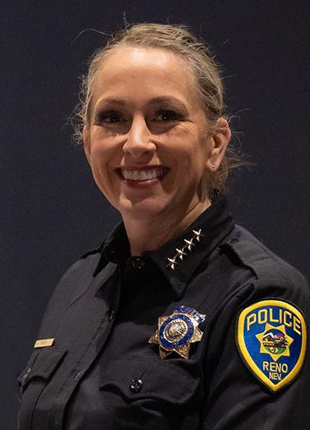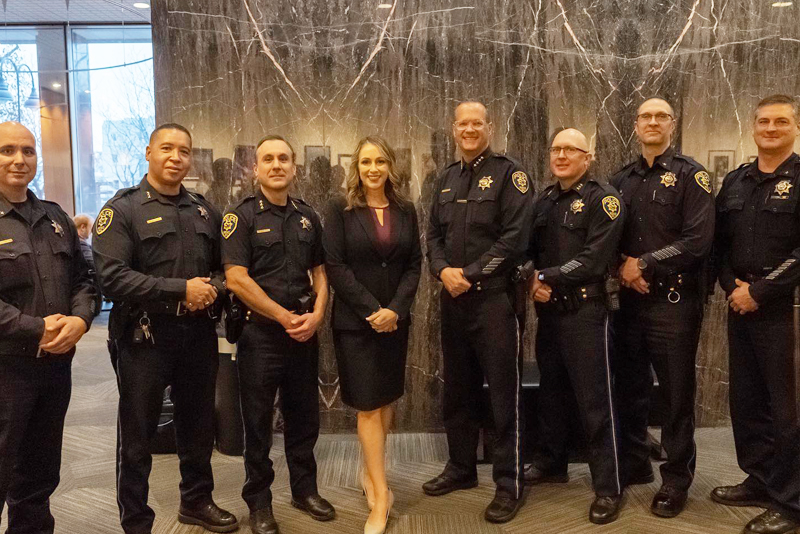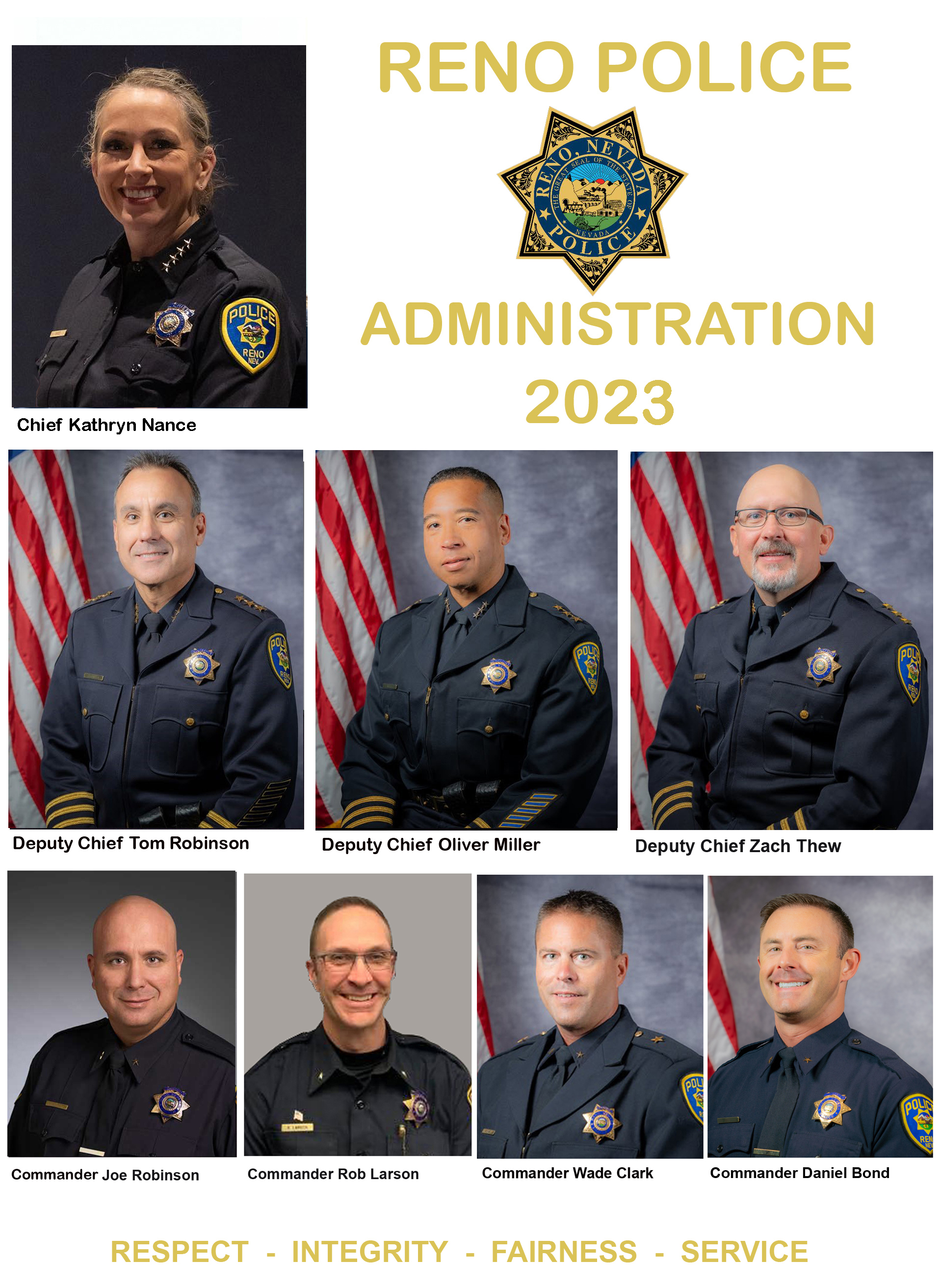
Kathryn Nance, Chief of Police
Reno Nevada
Police Chief Nance joined the Stockton California Police Department in 1996. She served as a Patrol Officer and Field Training Officer. She was also assigned to the Robbery/ Homicide Unit, Gang Violence Suppression Unit, and Crisis Negotiations Team.
Chief Nance was promoted to Stockton Police Sergeant on August 26, 2011, and worked in Patrol, Gang Street Enforcement Team, Community Response Team, Community Corrections Partnership Task Force and the AB109 Task Force.
Chief Nance was promoted to Stockton Police Lieutenant on December 3, 2016. As a Lieutenant, she was assigned to Field Operations and the Special Investigations Unit. She was also the Program Manager over METRO Narcotics, the Community Corrections Partnership Task Force, the FBI Task Force, the Multi-Agency Gang Task Force, Critical Incident Investigations, and the Parole and Corrections Team (PACT).
Chief Nance promoted to the rank of Captain on August 23, 2019, and served as commander of the Special Operations Division. On November 1, 2020, she promoted to the rank of Deputy Chief, where she lead the Logistics Bureau and Fiscal Affairs Division.
Chief Nance has earned her Intermediate, Advanced, Supervisory, and Management certificates from the California Peace Officer Standards and Training (POST). She has possessed her Master Officer certificate and graduated from the Sherman Block Supervisory Leadership Institute. Deputy Chief Nance obtained her Bachelor's Degree in Criminal Justice from Humphreys University in Stockton.
.
*** LINKS TO ADDITIONAL READING ***
Reno Police Department Audit 2021
Kathryn Nance, Chief of Police - 2023 - Current

Chief Kathryn Nance inherits an excellent command staff form retiring Chief Soto. From left to right: Commander Joe Robinson, Deputy Chief Oliver Miller, Deputy Chief Tom Robinson, Chief Katheryn Nance, retiring Chief Jason Soto, Deputy Chief Zach Thew, Commander Rob Larson, and Commander Sean Garlock.
RENO'S FIRST FEMALE CHIEF OF POLICE
by Jim Gibbs
In January 2023, Reno City Manager Doug Thornley recommended Deputy Chief of the Stockton California Police Department, Kathryn Nance to be Reno's next Chief of Police and first female Chief of Police. There are some who wondered why none of the well qualified Deputy Chief’s employed at the Reno Police Department never even bothered to apply. At least one of Reno’s top officers had made it clear that he was interested in the job. Another had applied in the past, but was not selected.
It is easy to assume that if you join a police department, your ultimate goal would be to become the leader of that department. In Reno, the select of chief has often been a source of contention between the members of the Reno Police Protective Association and the City Manager who makes the selection and recommendation to the Reno City Council. One year, not long ago, the RRPA ran a full-page advertisement in the local newspaper in support of one of three finalist and the City Manager recommended another to the City Council that seemed less qualified.
In 2022-2023 in seeking a replacement for Chief Jason Soto was it not only a surprise that no local candidates applied, but the City Manager used a survey of area wide citizens as input as a guide for his selection. If there was any problem with that, it was the small numbers of citizens that participated in the survey. Of the of the 761 participants of the survey, only 678 were Reno residents. Reno has a population of 274,602 people and, covers a city area of 111.58 sq mi.
The survey listed as concerns by the responders:
1. Violent crime prevention
2. Crime solving/investigations
3. Crime prevention
4. Fair and just policing
5. Response time reduction
6. Neighborhood quality of life
7. Enforcing lawful and orderly conduct
8. Community relations and engagement
9. Proactive youth engagement
10. Reducing racial disparities
11. Reducing police use of force
Ultimately, the selection was reduced to two candidates and quickly the nomination was given to Kathryn Nance a Deputy Chief of Police from Stockton California. The RPPA seemingly remained silent on the selection.
In the mid 70’s, the work environment for a female officer was hostile due to Chief of Police James Parker, a gutsy employee named Pam Engle turned to the courts for relief and won her case changing the Reno Police Department forever. While women have slowly made progress within the Reno Police Department, only one has ever been assigned to an administrative position.
On the other hand, the Reno City Council has seemingly become more and more progressive under the recent leadership of Mayor Hillary Schieve. It would not be surprising if a deliberate effort was made to recruit a female Chief of Police for Reno. Maybe, justifiably so.
In an article written by writer Dr. Gene Ira Katz and published online by Law Enforcement Today, it was pointed out that nationwide as of 2021, 60.3 percent of full-time civilian employees in US law enforcement agencies were women, but only 13.3 percent of full-time law enforcement officers were women, whereas 86.7 percent of officers were male, and less than 3 percent of police chiefs were female (1).
Louisiana boasts the highest proportion of women officers, at just over 22%, while West Virginia reports the lowest at 3.3% . (2)
Statistics like these are cautionary warnings for leaders in law enforcement, especially for those who understand that local police should mirror the populations in which they serve. (7) Margo Frasier, Police Monitor for Austin, TX, observed, “We make better decisions when those who are making the decisions for the community look like the community.” (3)
Deborah Friedl, a 30-year veteran with the Lowell, MA, Police Department, and the first woman to serve as their deputy superintendent expressed frustration that women have gotten almost no attention in policing. Dep. Superintendent Friedl, who is also vice president of the International Association of Women Police Officers, describes how discouraged she feels at this late stage of her career:
“There’s no energy about doing anything to recruit women or show any effort to do your best to recruit women.” (5)
Women in law enforcement.
Although decades of research have established the benefits of increasing women’s representation in policing (8), according to a report from the National Center for Women and Policing (NCWP), the numbers of women in law enforcement are kept artificially low purposefully through widespread discriminatory hiring practices (4).
The NCWP has been promoting plentiful and convincing research which clearly indicates that the surest pathway toward lowering the rates of violence against women — including sexual assault, rape, and murder — is to recruit more female officers (5).
Those are not the only benefits to be gained by increasing the number of women in the nation’s police agencies.
As reported by the NCWP, over twenty years of extensive research strongly indicates that women police officers generally employ a quality of policing based on far less physical force than traditionally used by their male counterparts, and they also rely much more on communication skills, which are known to be more effective in defusing potentially violent situations.
Reports also indicate that female officers are far less likely to perpetuate incidents of police brutality. Assistant Police Chief Crystal Young-Haskins, of the Little Rock, AR, Police Department explains:
“We hear the public when they criticize us about excessive force. There’s research out there that says that women are better de-escalators. They don’t resort to force first, they communicate first, and then uses of force become a last resort.” (10)
Female officers also tend to be considerably more effective when responding to situations involving violence against women, which comprise the largest category of calls to police agencies across the U.S. (6).
This is further underscored by crime-victimization data indicating that as female police presence increases in any given area, reports of crimes against women, particularly domestic violence, come in at significantly higher rates (5), which means that those victims have a better chance of putting a stop to the abuse as compared to situations that go unreported.
Austin Police Monitor Margo Frasier’s observation that those who are making the decisions for a community should look like that community, strongly suggests that police leadership across the US should seriously overhaul recruitment and retention practices insofar as women are concerned.
For one example, specifications for strength testing are almost universally based upon male physical characteristics, where upper body strength is an advantage.
In states like New Jersey, female recruits and sworn officers fail these tests at three times the rate of males. However, if such testing was readjusted to account for lower body strength, female officers would not be at such an unfair disadvantage (2).
The old-fashioned, authoritarian style of top-down management is typical in many, if not most, of America’s 18,000 police departments, along with the quasi-military tradition of ‘don’t question orders,’ which generally trickles down to reinforce authoritarian policing styles, where law enforcement takes charge of any given engagement without much room for civilian input.
This management style is not amenable to the gentler, more humanistic approach generally exhibited by female officers, who have a proven track record of being able to diffuse tense situations with a more cooperative, communicative approach (2).
One of the most forward-looking proposals to show up recently is the 30 by 30 Initiative, a national movement promoting the notion of having 30% of America’s sworn police officers be women by the year 2030.
This initiative is comprised of a coalition of police leaders, researchers, and professional organizations who have joined together to advance the representation and experiences of women in all ranks of policing across the United States, built upon decades of research that shows the unique benefits women officers bring to policing agencies, such as those already discussed here, and more.
30 by 30 has garnered active support from over 300 police agencies nationwide and is also promoted by the US Dept of Justice. (8) (9)
Just a few examples have been presented here that point to some of the positive long-term effects likely to result from recruiting and hiring more women as law enforcement officers, in addition to some of the changes required to improve female representation and effectiveness in America’s police departments. Heading into the future, it is the leadership of this nation’s police agencies who will need to take on the necessary commitment to advance the training and hiring of capable women, vital assets, who have been overlooked and underused for far too long.
References
1- Duffin, E., (2022), Gender distribution of full-time U.S. law enforcement employees 2021.
2-Retrieved from https://www.statista.com/statistics/195324/gender-distribution-of-full-time-law-enforcement-employees-in-the-us
3- Wedell, A., (2017), Women in law enforcement. Retrieved from https://www.n-r-c.com/gender-balance-law-enforcement/
4- National Center for Women & Policing, (2020), Changing the face of policing. Retrieved from
http://womenandpolicing.com/
5- Asquith, C., (2018), Why aren’t U.S. police departments recruiting more women? Retrieved from https://www.theatlantic.com/politics/archive/2016/08/police-departments-women-officers/497963/
6- Spillar, K., (2015), How more female police officers would help stop police brutality. Retrieved from https://www.washingtonpost.com/posteverything/wp/2015/07/02/how-more-female-police-officers-would-help-stop-police-brutality/
7- Ramsay, A., (2021), Diversity in policing: An educational assessment. Retrieved from https://www.blueline.ca/diversity-in-policing-an-educational-assessment
8- Policing Project at NYU School of Law, (2021), 30 X 30: Advancing Women in Policing: 30% Women Recruits by 2030. Retrieved from https://30x30initiative.org/
9- Goldsmith, M., (2022), More police departments are hiring women, here’s why. Retrieved from https://www.thv11.com/article/news/local/police-departments-more-women-recruits/91-ef6d1985-e10e-43bc-9f6d-b1c0cdf17575
CHIEF NANCE'S STORY TO THE TOP INCLUDES HER FAMILY
In 2018 Kathryn Nance, then a lieutenant with the Stockton Police Department, applied on a whim to take a test to become a captain and never gave it much thought afterwards.
A week later on the morning of Aug. 28, 2018, everything changed when her fellow police officer and husband, James “Jamie” Nance, was critically injured during an on-duty motorcycle accident while on traffic duty.
The 49-year-old father of four adult children survived the head-on collision with an SUV but suffered severe injuries: 11 broken ribs, a flailed chest, two collapsed lungs and compound fractures to his lower left leg. There was also irreparable spinal cord damage that left him a paraplegic in need of a wheelchair for the rest of his life.
While sitting beside her husband in his hospital room, Kathryn Nance admitted she quit everything, whether it be deciding what she ate, how she dressed, or responding to texts and work emails.
The one person that did not quit on her was Jamie, Kathryn Nance said, who continued to push his wife of 14 years to keep pursuing the captain position.
Nearly a year later, that continued support for each other would lead to another historic moment for the Stockton Police Department when Kathryn Nance was officially promoted to the rank of captain during a promotion ceremony Friday at the downtown police headquarters.
Police Chief Eric Jones said the ceremony was additionally special considering that she is the second woman ever promoted to captain in the 169-year history of the department. The only other woman to do so was Tammie Murrell in 2008.
“It was because of Jamie, no matter what my idea was, no matter what my needs were, no matter what I desired, no matter what my goals were, he was not going to let that go to wayside,” Kathryn Nance, then 44, said to a packed room of family, friends and uniformed colleagues.
“Even when he was in his most vulnerable state and couldn’t take care of himself, he was going to make sure that I was taken care of and what I wanted to do was going to happen.”
Kathryn Nance was first hired by the department as a police officer in September 1996, according to Jones. Nance rose through the ranks and eventually was promoted to sergeant in August 2011 and lieutenant in December 2016.
Among the career highlights Jones touched on was of her investigative work. She led an investigation into a gang conflict involving 11 separate shootings resulted in the arrest of seven gang members for attempted murder.
“I have no doubt that she’s going to be an excellent commander for this Police Department, for this community and for this city,” Jones said of his Stockton Police Department. “Achieving the rank of police captain, she absolutely has an immense amount of credibility within the Police Department, so you’ve earned it.”
Nance’s remarks were at times deeply personal, peppered with humor and emotional as she wiped away tears throughout her speech.
She dedicated her promotion to those who have supported her most, including her children, friends, and members of the community. But most importantly, she thanked her husband, who never stopped believing in her, even in the midst of the most dire of situations.
“I’m the one up here right now with my pretty new captain bars and shiny new badge and a job that will hold a whole lot of responsibility and opportunity; this promotion is absolutely not mine,” Nance said.
It was only fitting that it was Jamie Nance who pinned the new badge to her uniform and the two shared a kiss to a round of applause
Now, she is Reno's Chief of {Police.

As Chief Kathryn Nance steps into her new position, she has the backing of a very experienced command staff and for all intent and purposes, little change should be noticed at the Reno Police Department..
As Chief Kathryn Nance steps into her new position, she has the backing of a very experienced command staff and for all intent and purposes, little change should be noticed at the Reno Police Department..
CHIEF NANCE INHERITS THE JOB OFREPLACING A 72-YEAR-OLD POLICE STATION
In September 2019, the City of Reno closed on purchasing the Reno Gazette Journal building. The purchase of the 7-acre property, which will serve as the new headquarters for the Reno Police Department cost the City of Reno just under $7 million. Cost was a key issue for those who raised concerns about the purchase.
The move to a new building was necessary given the issues with the current Reno Police Department headquarters, built in the late 1940’s and occupied by RPD in January 1950. The cost of repairing the old RPD facility alone — estimated at about $8 million — is higher than the purchase price of the RGJ building. Even if asbestos remediation and other repairs are done, the building is still smaller.
“There are police officers working out of converted jail cells in the current building,” City Manager Newby said. “It really is kind of a dire situation that just needs to be addressed.”
Moving from 68,000 square feet to the RGJ’s 108,000-square-foot facility will also allow the RPD to bring community groups into the station to improve efforts on issues such as victim services.
The city is already working with an architect to look at adjustments needed to make the RGJ building conform to the city’s use. The Reno Police Department is looking at a move-in date of June 2021, with an estimated 450 personnel affected by the move.
The remolding, and the move in general bring upon the admiration staff extra work to get it done. In an interesting twist, the Reno Police Station constructed in the early 1900’s sat side by side with the Reno Gazette on Center Street.
Please enjoy this online version of "The History of Policing Reno".

SHARE THIS PAGE!